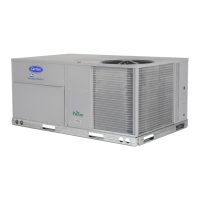11
NOTE: Trap should be deep enough to offset maximum unit static
difference. A 4” (102) trap is recommended.
MINIMUM PITCH
1” (25mm) PER
10’ (3m) OF LINE
BASE RAIL
OPEN
VENT
TO ROOF
DRAIN
DRAIN PLUG
ROOF
CURB
SEE NOTE
2˝ (51) MIN
C08022
Fig. 14 -- Condensate Drain Piping Details
All units must have an external trap for condensate
drainage. Install a trap at least 4-in. (102 mm) deep and
protect against freeze-up. If drain line is instal led
downstream from the external trap, pitch the line away
from the unit at 1-in. per 10 ft (25 mm in 3 m) of run. Do
not use a pipe size smaller than the unit connection
(
3
/
4
-in.).
Step 10 — Make Electrical Connections
ELECTRICAL SHOCK HAZARD
Failure t o follow this warning could result in personal
injury or death.
Do not use gas piping as an electrical ground. Unit
cabi net must have an uninterrupted, unbroken
electrical ground to minimize the possibility of
personal injury if an electrical fault should occur. This
ground may consist of elect rical wire connected to
unit ground lug in control compartment, or conduit
approved for electrical ground when installed in
accordance with NEC (National Electrical Code);
ANSI/NFPA 70, latest edition (in Canada, Canadian
Electrical Code CSA [Canadian Standards
Association] C22.1), and local electrical codes.
!
WARNING
NOTE: Check all factory and field electrical connections
for tightness. Fie ld--supplied wiring shall conform with
the limitations of 63_F(33_C) rise.
Field Power Supply —
If equi pped with optional Powered Convenie nce Outlet:
The power source leads to the convenience outlet’s
transformer primary a re not factory c onnected. Installer
must connect these leads according to required operation
of t he convenience outlet. If an always--energized
conveni ence outlet operation is desired, connec t the
source leads to the line side of the unit--mounted
disconnec t. (Check with local code s to ensure t his method
is acceptable in your area.) If a de --energize via unit
disconnec t switc h opera tion of the convenience outlet is
desired, connect the source leads to the load side of t he
unit disconnect. On a unit without a unit--mounted
disconnec t, connect the source leads to compressor
contactor C and indoor fan conta ctor IFC pressure lugs
with unit field power leads.
All units except 208/230-v units are factory wired for the
voltage shown on the nameplate. If the 208/230-v unit is
to be connected to a 208-v power supply, the control
transformer must be rewired by moving the black wire
with the
1
/
4
-in. f emale spade connector from the 230--v
connec tion and moving it to the 208-v
1
/
4
-in. male
terminal on the primary side of the transformer. Refer to
unit la bel diagram for additional information. Field power
wires will be connected line--side pressure lugs on the
power terminal block or at factory--installed option
non--fused disconnect.
Field power wires are connected to the unit at line--side
pressure lugs on compressor contactor C and indoor fan
contactor IFC or terminal board (see wiring diagram label
for control box component arrangement) or at
factory--installed option non--fused disconnec t switch.
Max wire size is #2 AWG (copper only). (See Fig. 16)
NOTE: TEST LEADS -- Unit may be equipped with
short leads (pigtail s) on the field line connection points on
conta ctor C or optional disconnect switch. These leads are
for factory run--test purposes only; remove and discard
before connecting field power wires to unit connection
points. Make field power connect ions directly to line
connec tion pressure lugs only.
!
WARNING
FIRE HAZARD
Failure to follow this warning could result in
intermittent operation or perfor mance satisf action .
Do not connect aluminum wire between disconnect
switch and furnace. Use only copper wire.
(See Fig. 15.)
COPPER
WIRE ONLY
ELECTRIC
DISCONNECT
SWITCH
ALUMINUM
WIRE
A93033
Fig. 15 -- Disconnect Switch and Unit
Units Without Factory--Installed Disconnect —
When installing units, provide a disconnect switch per
NEC (National Electrical Code) of adequate size.
Disconnect sizing data is provided on the unit informative
plate. Locat e on unit cabinet or within sight of the unit per
national or local code s. Do not cover unit informat ive
plate if mounting the di sconnect on the unit cabine t.
50TCQA

